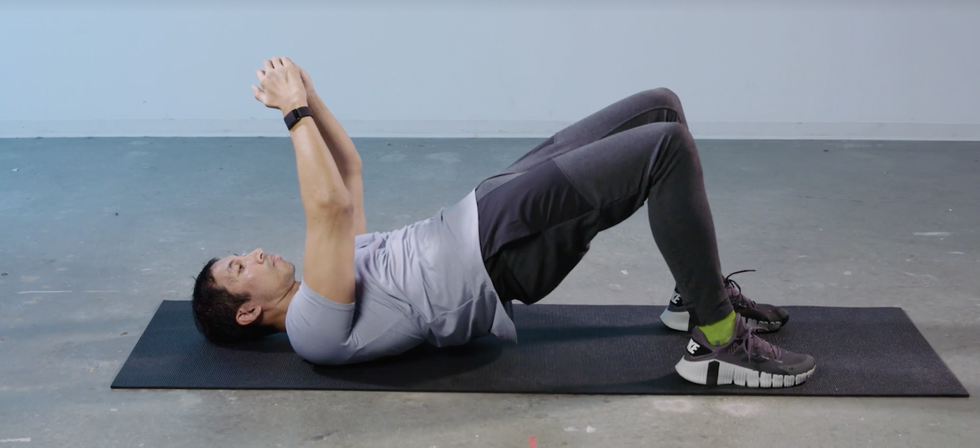WHETHER YOUR DAILY life includes pulling heavy weight off the floor or pulling 10-hour workdays in front of the computer, you’re going to rely on a strong set of glutes.
The truth is you can never focus too much on your glutes. The muscles help protect your spine, and another key function of your gluteus maximus, hip extension, helps to propel you forward when you walk, run, or jump.
When you think about training the glutes, heavyweight exercises like deadlifts and kettlebell swings might be the first thing that comes to mind. But working with a full gym’s worth of equipment isn’t always an option. One simple alternative is always available, and it’s a viable move for just about everyone: the glute bridge.
Who Should Do the Glute Bridge
This simple move can be done by just about anyone, of any skill level, virtually anywhere— from a mat on your gym to the spot on the floor next to your office desk, says Men’s Health fitness director Ebenezer Samuel C.S.C.S.
Experienced lifters can use it as a warm up before those heavy pull exercises mentioned above, while beginners and even office workers can do the bridge to get their glutes firing.
Which Muscles You’ll Work Doing the Glute Bridge
According to Samuel, the glute bridge provides plenty of big time benefits to much more than just your glutes.
“The glute bridge is really going to isolate your glutes, and it’s going to hit your hamstrings a little bit too,” Samuel says. “And what I really like about the glute bridge for the general population is it’s going to teach us what our core is supposed to do in order for us to focus on and this is an exercise that we can take anywhere.”
How to Do the Glute Bridge
Setting up for a glute bridge is simple—so much so that you can do it quickly next to your desk at the office.
- Start by lying on the floor.
- Bend your knees and plant your feet flat on the ground, keeping your heels close to your butt.Your feet should be about a foot apart, or just wider than shoulder-width apart.
- Your knees should be close, but not touching. You’re going to need a little bit of separation in order to help drive yourself into hip extension as you drive your hips toward the ceiling. (As your hips begin to open, you’ll also experience a bit of external rotation.)
- Squeeze your core to create tension. Keep your ribcage tight. At the same time, think about creating tension by squeezing your shoulder blades (for added upper-body tension).
- Squeeze your glutes to push your hips up off the ground, keeping the tension in your glutes, core, and shoulders. You can raise your hands up to help cue yourself to actively drive your shoulder blades into the floor.
- Hold for one to two seconds at the top. Keep your abs tight and avoid arching your back.
- Return to the starting position.
The hip height for your glute bridge should depend on a few factors. Because each person has different strengths and limitations, there really is no set height for your glute bridge to reach. Beginners (and even those suffering from hip flexor tightness) may not reach as high. An optimal goal for anyone should be to aim for a straight shot from your knees to shoulders (without ever arching your back). There’s plenty of time to work on that mobility to create that perfect line.
How Often to Do the Glute Bridge
The glute bridge can be included in workout routines in a few different ways. For beginners, start with three to four sets of 10 to 12 reps. This range will help to get a good feeling for the movement—which can ultimately transfer to other exercises like deadlifts and kettlebell swings.
For more advanced trainees, the glute bridge will be a valuable warmup for those heavy training days. Try going 30 seconds on, 30 seconds off for about three rounds to get your glutes firing.
If you’re stuck at the office, don’t be afraid to get down to activate your lower body muscles during a long day of sitting. You can drop to the floor next to your chair a few times throughout the day and knock out a few reps throughout the workday. Maybe your co-workers will join you on the ground as well… eventually.
Jeff Tomko is a freelance fitness writer who has written for Muscle and Fitness, Men’s Fitness, and Men’s Health.
Brett Williams, a fitness editor at Men’s Health, is a NASM-CPT certified trainer and former pro football player and tech reporter who splits his workout time between strength and conditioning training, martial arts, and running. You can find his work elsewhere at Mashable, Thrillist, and other outlets.



Comments are closed.